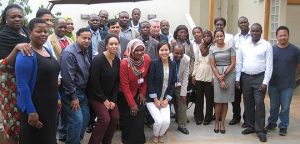The United Nations Framework Convention on Climate change (UNFCCC) is a collaboration of countries which seek to reign in anthropogenic climate change as much as possible, and respond effectively to its potential threats. A key part of the UNFCCC agreement involves “capacity-building”: efforts to improve nations’ abilities to meet the UNFCCC’s mitigation and adaptation goals (“Understanding Capacity-Building”). The UNFCCC promotes capacity-building measures to reach those with the fewest resources, and those which face the greatest dangers. These programs help to level the playing field so that vulnerable populations have a fair opportunity to improve their own situation, and have the ability to help improve the global situation.

One capacity building project strated in 2014 involved the setup of climate change research tools in some of Brazil’s public schools. Retrieved from United Nations Framework Convention on Climate Change.
The UNFCCC has laid out “frameworks,” or basic strategies, of capacity-building for two specific groups of countries: developing countries and those with economies in transition (“Understanding Capacity- Building”). Whereas those in the first category are in the process of raising their standard of living, those in the second are shifting from government controlled economies to having independently operating companies (Cambridge Dictionary). Countries in both framework categories are undergoing major shifts in economic, political, and other social systems, which may make it difficult for them to focus on climate change issues. Developing countries also lack the monetary and technological resources which industrially developed countries can use to deal with climate change. However, the period of change provides opportunities to redesign social systems to better promote climate-friendly behaviors and resilience to climate related threats. Therefore, a focus on capacity building in these countries makes sense because it is especially necessary and can also be especially transformative.
Programs such as the European Capacity Building Initiative, run by the International Institute for Environmental Development, put UNFCCC frameworks into action by providing educational workshops and other forms of training (“Workshops”). To provide easy access to information on initiatives around the world, the UNFCCC has developed a Capacity-Building Portal which organizes programs by country and provides links to more information. Hundreds of programs are complete or currently active, and take on the form of workshops, efforts to influence government policy, and other initiatives according to countries’ various needs.

“Participants of the 2014 ecbi pre-COP training workshop for LDC negotiators, Lima.” Retireved from International Institute for Environment and Development.
The UNFCCC also aims to provide tools specifically to women, who often face the greatest climate change-related risks because of social systems that prevent them from protecting themselves. Much of their vulnerability stems from poverty. The UN guidebook Gender, Climate Change and Community-Based Adaptation explains that “poor women’s limited access to resources, restricted rights, limited mobility and voice in community and household decision-making” are all factors which put them disproportionately at risk (ii). These factors may also prevent women from benefiting as much as men do from capacity building programs. The guide calls for programs to actively compensate for gender inequalities. Programs that follow this advice would not only benefit individual women, but could also provide them with the tools to better serve their families and communities.
If they work as planned, capacity building efforts should lessen the strain of dealing with climate change on vulnerable individuals and nations, and overall. By providing tools to combat climate change to those who otherwise would not have access, they distribute the burden over a larger group of people, and they lessen the overall burden by helping people to solve problems in the most efficient way possible. Furthermore, capacity building provides agency to disadvantaged populations. Once they have the capacity to effectively mitigate and adapt to climate change, they can make their own informed decisions on how to do so rather than having the decisions of other groups imposed upon them.
References
Gender, Climate Change and Community-Based Adaptation. New York: United Nations
Development Programme, 2006.
<http://www.undp.org/content/dam/aplaws/publication/en/publications/environment-energy/www-ee-library/climate-change/gender-climate-change-and-community-based-adaptation-guidebook-/Gender%20Climate%20Change%20and%20Community%20Based%20Adaptation%20(2).pdf>
“Transition Economy.” Cambridge Dictionary, Cambridge University Press 2017. <http://dictionary.cambridge.org/us/dictionary/english/transition-economy>.
“Understanding Capacity-Building, Education and Outreach.” United Nations Framework
Convention on Climate Change. http://bigpicture.unfccc.int/
“Workshops That Build Climate Negotiators’ Capacity: European Capacity Building Initiative Training and Support Programme.” International Institute for Environment and Development. <https://www.iied.org/workshops-build-climate-negotiators-capacity- european-capacity-building-initiative-training-support>
